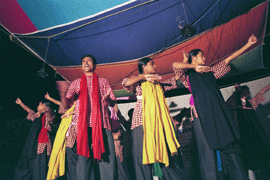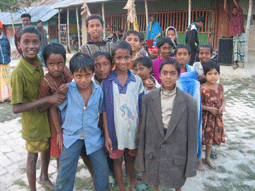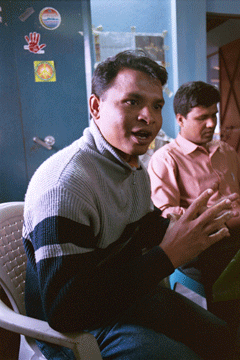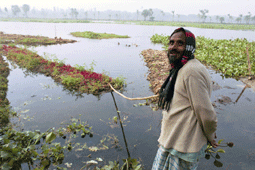Early Signs: Bangladesh
Air Date: Week of April 21, 2006

Actors in the play, "Environmental Thinking: Where will we go?" dance and wail to bring the message of climate change to hundreds of villagers in southwest Bangladesh. (Emilie Raguso)
When scientists discuss countries at risk from the potential effects of climate change, they point to Bangladesh. Just above sea level, and in the flood plain of the Ganges and Brahmaputra rivers, 144 million people live in a space the size of Wisconsin. Producers Sandhya Somashekhar and Emilie Raguso report on what’s at stake for Bangladesh.
Transcript
CURWOOD: It’s Living on Earth. I’m Steve Curwood. The most populated nation directly in the crosshairs of global warming is Bangladesh. With tens of millions of people living at or just slightly above sea level, many of the citizens of this impoverished and overcrowded country could be forced to flee their homes before the century is out. International aid organizations and the Bangladeshi government are working to increase the ability of people to survive the rapidly changing environment. But it’s a tough race against time and tides.
Today we continue our series "Early Signs: Reports from a Warming Planet." The series is a collaboration of the UC-Berkeley Graduate School of Journalism, Salon dot com, and Living on Earth to document places around the world where concerns about climate change are already having an impact. Producers Sandhya Somashekhar and Emilie Raguso have today’s story from Bangladesh, which Ms. Somashekhar narrates.
[PEOPLE TALKING, KIDS TALKING, SOUND CHECK, BELLS, GENERATOR SOUND, DRUMS]
SOMASHEKHAR: It’s sunset in the jungle, and four musicians are tuning a drum and harmonium on stage.
[HARMONIUM SOUND, MORE SOUND CHECK]

Local children were some of the first to check out what all the noise was about during the play's sound check. (Sandhya Somashekhar)
[BANGLA SONG]
SOMASHEKHAR: As the play opens, a dozen performers in red-and-white-checkered costumes act out a happy village scene. They collect lotus flowers and tend to their chickens and goats. Suddenly, a storm hits, flooding the entire village.
[STORM SOUND, MAN WEEPING, FLUTE]
SOMASHEKHAR: The play, called “Environmental Thinking: Where will we go?” is about the dangers of climate change. Floods, droughts, cyclones and saltwater pollution of farmland all appear in this show, just as they may someday in this very village.
MONDAL: To the village people, plays and dramas are a great source of entertainment and joy, because they don’t really have access to cinema. So whatever you say in a drama or a play, people remember it better.
SOMASHEKHAR: Mohon Kumar Mondal is an environmental activist with the local group Working for Coastal People. He helped to bring this play to southwest Bangladesh, where he grew up working the rice paddies with his father. Already, the ocean has begun to seep into the freshwater supply here. As a result, crops fail and people now walk miles for drinking water. So far, the main causes of this problem are massive dams built upriver in India and other man-made factors. But climate change will worsen the situation.

Mohon Kumar Mondal talks with CARE officials about climate change awareness programs in southwestern Bangladesh. (Emilie Raguso)
SOMASHEKHAR: Few doubt that global warming will bring disaster for Bangladesh, where 144 million people live in a space the size of Wisconsin. And the country is plagued year after year by natural disasters. Now comes climate change. Warmer temperatures will increase the intensity of cyclones that churn up over the Bay of Bengal and make the weather more unpredictable. Researchers have noticed that floods along the country’s three major rivers are happening more frequently, a trend that will worsen. But the most alarming effect of climate change is sea level rise. Within the next 100 years, the oceans could rise by a meter or more, inundating the coastal areas and devastating prime agricultural land.
HUQ: Firstly, it is a low-lying deltaic country, with large parts of the country just within one meter of the mean sea level. And if sea levels rise by a meter, that means that a large part of the country, something like 10 percent, will go under water.
SOMASHEKHAR: Saleemul Huq is a plant scientist and founder of the Bangladesh Center for Advanced Studies, the country’s top climate change research and policy organization. Some predictions say the land lost with a meter sea level rise could be almost twice as much.
HUQ: What makes Bangladesh distinct is the huge numbers of people that are at risk. If I take the coastal area, then with current populations there are about 20 million people living there. And over the next 50 years that size population is probably going to grow by at least another half. So the numbers of people that will probably have to be relocated, will have to move, will certainly have to change their livelihoods to survive, are in the tens of millions.
SOMASHEKHAR: Michael Oppenheimer, a professor of geosciences and International Affairs at Princeton, agrees.
OPPENHEIMER: If even a modest chunk of the Greenland Ice Sheet or the West Antarctic Ice Sheet goes, the sea level would rise past the capital of Dhaka, which is the center of the country. And untold tens of millions of people live between Dhaka and the sea right now.
[DHAKA CITY SOUNDS; TRAFFIC, CROWS, RICKSHAWS]
SOMASHEKHAR: Dhaka: one of the fastest growing cities in Asia. The air here is thick with diesel and the odor of open sewers, which hovers in a gritty cloud over the city’s unmapped tangle of roads and alleyways. Amid the clamor of trucks, two-wheelers and bicycle rickshaw bells, loudspeakers broadcast the Azan, or Muslim call to prayer.

Dhaka, the capital of Bangladesh, is one of Asia's fastest growing cities. (Emilie Raguso)
SOMASHEKHAR: Every inch of this city is crammed with people, about 10 million of them. The Bangladeshi government here is well aware of the changes likely to be visited upon the country. There is a new climate change cell within the Department of Environment. And last year, with funding from the United Nations, it completed a National Adaptation Plan of Action, which proposed reforesting the coast, finding new sources of drinking water, and spreading awareness.
Massive international assistance will be necessary to weather this storm, says Mustafa Abu Kamaluddin, an environmental consultant working for the Bangladesh government.
KAMALUDDIN: Maybe it will be helpful and better adaptation if the international community that was responsible, they will come forward. If not then maybe some percentage of my people will die. Maybe they have to pay. I mean, we have overcome always, but we paid for that. Thousands of our people have been killed, but as a nation we survived.
SOMASHEKHAR: One of those people at risk is Ismail Hossain, a rural farmer living on the banks of the Kabadakshya River. He knows nothing about melting glaciers or carbon emissions, but he is intimately familiar with nature’s ferocity. Though his small village seems an oasis of palm trees and thatched huts, the river often spills over during the rainy season, flooding homes and turning emerald fields of rice into pools of mud.

Ismail Hossain attends his floating gardens, built on bamboo and water hyacinth. The gardens give him more room to grow fresh crops, like red spinach and tomatoes. (Emilie Raguso)
HOSSAIN: At first I thought that the water will never go and that everything has been destroyed forever. Everything you are seeing was underwater. If I wanted to go anywhere else I had to call a boat and go everywhere through boats.
SOMASHEKHAR: The international aid agency CARE has been trying to teach people like Mr. Hossain to build stronger houses, carve moats around their homes and switch to salt-resistant crops, all in anticipation of climate change. He learned to build gardens that literally float on the water, an indigenous technique that he improved upon himself.
HOSSAIN: I first placed bamboos on the water and then pulled some of the water hyacinth on the bamboos. Then I collected the mud and put the seeds in the mud. Within four or five days, the seed came up and there was a beautiful tree coming out of the seed. Many people came here to see such an amazing thing.
SOMASHEKHAR: Mr. Hossain now has 13 vegetable gardens resting on the surface of the river, oblong beds overflowing with tomatoes and pale green bottle gourds. Still, he senses the worst is yet to come.
HOSSAIN: In the rainy season, the rain isn’t coming in due time, and in the winter it isn’t as cold as it used to be. I realize that the seasons are changing as the time goes on. I fear that something like this can happen in the future. But if such things happen and I can’t grow vegetables anymore, I will find a way to survive.
SOMASHEKHAR: Then he said something you often hear here.
HOSSAIN: When there is trouble, there is a way. (Laughs)
SOMASHEKHAR: People here can’t afford to be deterred by nature’s hardships. For example, there are people who live their entire lives on boats. Others – millions, in fact – live on sandbars that rise just a few inches from the surface of the sea. Land that could very well wash away during the next big cyclone.
But it is increasingly clear that Bangladeshi resourcefulness may not be enough to pull them through the coming changes. Eventually, many millions of people might have to flee the country, or die.
ULLAH: So, if it goes underwater, we have to move these people. Where do you move these people?
SOMASHEKHAR: Mahfuz Ullah is an environmentalist and journalist who has become something of a crusader for climate change awareness in Bangladesh. On a map of the country, he traces an arc across the jagged southern coastline – part beach, part wetland, part dense forest. That, he says, is the part of the country most likely to go under. It’s home to the Sundarbans National Forest, the world’s largest mangrove forest and the abode of the infamous man-eating Royal Bengal Tiger. It is also some of the continent’s most densely populated terrain.
ULLAH: If it comes to the question of relocating 100,000 people or even 50,000 people, it will be very difficult for the Bangladesh government to really relocate them.
SOMASHEKHAR: But others consider even that scenario far too rosy. Princeton’s Michael Oppenheimer talks of planning the evacuation of tens of millions of people.
OPPENHEIMER: In the long term the land is going, going, gone for a good chunk of the country. It seems to me that plans for the worst case need to be made. And that would mean a substantial withdrawal of a lot of the population.
SOMASHEKHAR: But no such plans are underway.
Ahsan Uddhin Ahmed is executive director of the food and policy research group, Bangladesh Unnayan Parishad. He says the Bangladesh government already has its hands full with today’s problems.
AHMED: With limited resources, our policymakers are not really prepared to spend money for something which will happen maybe 30, maybe 35 years later. They have immediate problems – you know, poverty reduction, educating all these people, providing primary healthcare services. So there comes a question how international community will come up and help our people, our government. If we leave the needs of adaptation onto the shoulder, or rather weak shoulder, of our government, then probably it will be another disaster.
SOMASHEKHAR: Until such assistance arrives, it will be up to the people to cope with changes that most will not understand.
[RADIO PROGRAM]
SOMASHEKHAR: Radio programs like this one, produced by CARE, are one way the message of climate change is reaching average Bangladeshis.
MONDAL: (in English) Black smoke.
SOMASHEKHAR: Mohon Kumar Mondal, the activist who helped bring the climate change play to the village, also uses a large flipchart with vivid illustrations of daily village life to spread the word.
[PAGES RUSTLING]

CARE created this flipchart, full of colorful images familiar to rural life, to help organizers teach villagers about the perils of climate change.
(Emilie Raguso)
SOMASHEKHAR: Most of these sources of emissions are luxuries Mr. Mondal’s audiences can’t even imagine. So he tries to use images that people recognize. One page of the flipchart shows a truck barreling along the road, a murky cloud escaping from the tailpipe. Behind are the tall smokestacks of brick kilns, a familiar presence on the landscape of southern Bangladesh.
[PAPER RUSTLING]
SOMASHEKHAR: Another shows cracked earth, made barren from saltwater pollution. Despite Mondal’s efforts, not everyone gets the message.
MONDAL: There are all sorts of reactions. First, a certain type of people say “Oh, scientists say a lot of things. And we have lived here for so many years and nothing has happened. Now something will happen in 30 years here? That can’t be.” That’s one type of opinion. Then, another group of people, those who believe in science, or those who are educated, they realize that we are witnessing things like sea level rise, the salinity. So they realize these things are true.
SOMASHEKHAR: When you ask people here about the coming changes they point out that they emit less than one percent of the world’s greenhouse gases, yet may well suffer the most in a warmer world. Journalist and environmentalist Mahfuz Ullah.
ULLAH: We are not responsible for climate change. We are not responsible for global warming. To what extent? We are paying for it. We will have to pay for it.
SOMASHEKHAR: If you ask if the country will be able to cope, people invariably point out that they already suffer every kind of natural disaster except volcanoes and they haven’t been wiped off the map yet. If you suggest that perhaps the government should consider an evacuation plan for the coast, they ask, then why not evacuate New Orleans? Mr. Ullah firmly believes in his country’s ability to adapt.
ULLAH: People of this country are resilient. At a personal level, I am an incurable optimist. And I know and have seen people, how do they cope with natural disaster. So, this is another natural disaster, for us. You know, this is a basic human instinct. We all want to survive. And this survival instinct will always keep people floating above the water.
SOMASHEKHAR: It would be foolish to underestimate Bangladeshi ingenuity, or the technological advances that could unfold in the coming years. But there is more than ever at stake for this drenched and downstream place, where so many people live at nature’s whim.
[MUSIC: Bangladeshi Street Music Troupe (anonymous)]
CURWOOD: Our story on Bangladesh was produced by Sandhya Somashekhar and Emilie Raguso as part of our series, “Early Signs: Reports from a Warming Planet.” “Early Signs” is a collaboration of the UC-Berkeley Graduate School of Journalism, Salon dot com, and Living on Earth. To read a print version of our story on Bangladesh and see photos of life in that delta nation, visit our website Living on Earth dot org. That’s Living on Earth dot O-R-G.
 |
 |  |  |
Living on Earth wants to hear from you!
Living on Earth
62 Calef Highway, Suite 212
Lee, NH 03861
Telephone: 617-287-4121
E-mail: comments@loe.org
Newsletter [Click here]
Donate to Living on Earth!
Living on Earth is an independent media program and relies entirely on contributions from listeners and institutions supporting public service. Please donate now to preserve an independent environmental voice.
NewsletterLiving on Earth offers a weekly delivery of the show's rundown to your mailbox. Sign up for our newsletter today!
 Sailors For The Sea: Be the change you want to sea.
Sailors For The Sea: Be the change you want to sea.
 The Grantham Foundation for the Protection of the Environment: Committed to protecting and improving the health of the global environment.
The Grantham Foundation for the Protection of the Environment: Committed to protecting and improving the health of the global environment.
 Contribute to Living on Earth and receive, as our gift to you, an archival print of one of Mark Seth Lender's extraordinary wildlife photographs. Follow the link to see Mark's current collection of photographs.
Contribute to Living on Earth and receive, as our gift to you, an archival print of one of Mark Seth Lender's extraordinary wildlife photographs. Follow the link to see Mark's current collection of photographs.
 Buy a signed copy of Mark Seth Lender's book Smeagull the Seagull & support Living on Earth
Buy a signed copy of Mark Seth Lender's book Smeagull the Seagull & support Living on Earth

